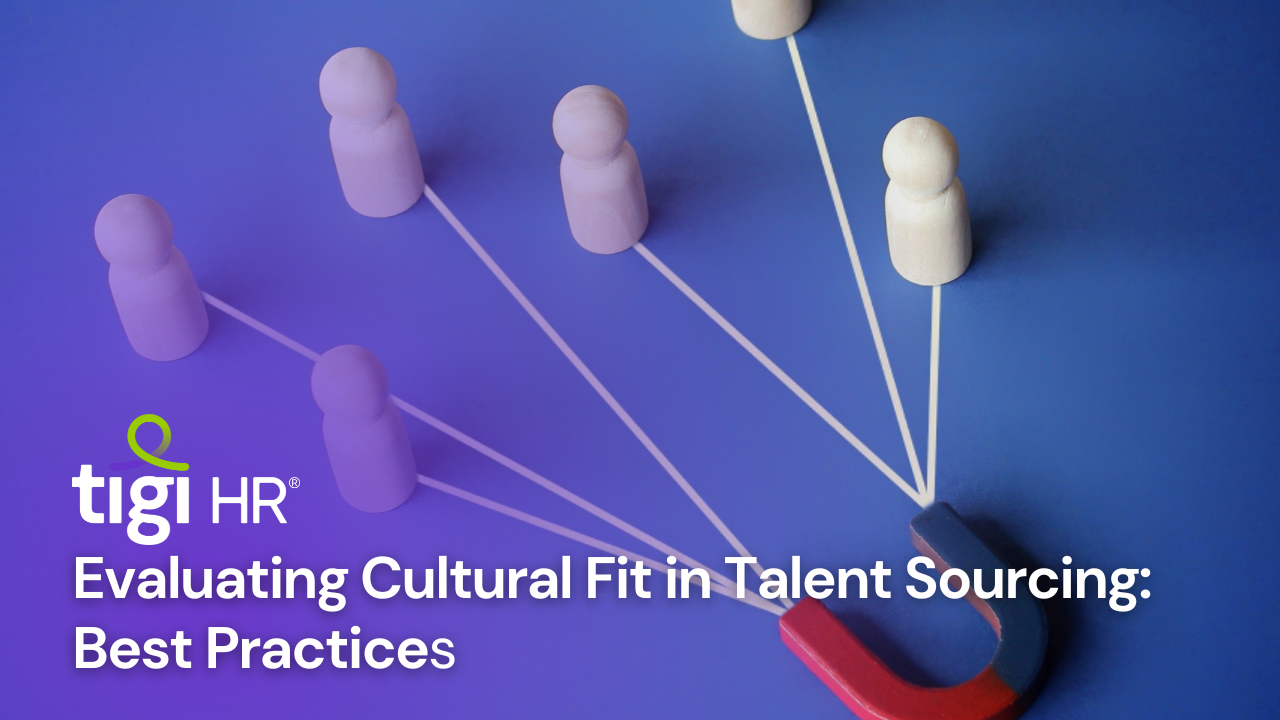Understanding the Concept of Cultural Fit
Cultural fit is a critical yet often elusive aspect of talent sourcing and recruitment. It refers to the alignment between a candidate’s values, beliefs, and behaviors with the culture of the organization they are applying to join. Understanding this concept is vital as it plays a fundamental role in employee satisfaction, engagement, and overall organizational success.
To gain a deeper understanding of cultural fit, it’s essential to recognize that it’s not about finding individuals who are identical to the existing employees. Instead, it’s about finding individuals whose values and working styles complement and harmonize with the organization’s culture.
Research has shown that cultural fit is a strong predictor of job satisfaction and long-term retention. According to a study conducted by Deloitte, 94% of executives and 88% of employees believe a distinct workplace culture is crucial for business success. Moreover, the Society for Human Resource Management (SHRM) reports that organizations with a strong cultural fit experience 20% less turnover and 30% higher employee engagement.
In practice, understanding cultural fit involves an in-depth examination of the company’s values, mission, and the behaviors that are rewarded or discouraged within the organization. Recruiters and HR professionals need to assess a candidate’s alignment with these factors, looking beyond qualifications and skills to determine if they will thrive in the company’s environment.
By grasping the nuances of cultural fit, organizations can not only make better hiring decisions but also create an environment where employees are more likely to excel and remain loyal. It’s a delicate balance that requires both qualitative and quantitative analysis to ensure that the right talent is not only brought into the organization but also retained for the long term.
The Importance of Cultural Fit in Talent Sourcing
The importance of cultural fit in talent sourcing cannot be overstated. It’s a critical factor that directly impacts an organization’s performance, employee satisfaction, and overall success. Cultural fit goes beyond just hiring based on skills and qualifications; it’s about finding individuals who align with the values, beliefs, and working norms of the company.
Statistics highlight the significance of cultural fit in the hiring process. A study conducted by the Harvard Business Review found that 80% of employee turnover is due to poor cultural fit. This indicates that organizations that overlook cultural fit in their talent sourcing strategy are more likely to face higher turnover rates and the associated costs.
Furthermore, the impact of cultural fit on employee engagement is substantial. Gallup reports that only 34% of U.S. workers are engaged in their jobs, leading to productivity losses. When employees feel a strong cultural fit, they are more likely to be engaged, resulting in higher productivity, increased innovation, and better overall performance.
Cultural fit also plays a role in attracting top talent. According to Glassdoor, 77% of job seekers consider a company’s culture before applying for a job. This means that organizations with a strong cultural identity are more likely to attract the best candidates.
Identifying Organizational Culture
Identifying and understanding an organization’s culture is a fundamental step in the process of evaluating cultural fit in talent sourcing. Organizational culture is the unique set of values, beliefs, behaviors, and norms that shape how work is conducted within a company. It serves as the foundation upon which the entire work environment is built.
To effectively identify the culture of an organization, it is essential to consider both the stated culture (what is written in mission and value statements) and the actual culture (how things are done in practice). This distinction is crucial because there can often be a gap between what an organization aspires to be and the reality of its day-to-day operations.
Insights and statistics emphasize the significance of correctly identifying an organization’s culture. Research conducted by HR consulting firm Mercer revealed that 62% of executives believe cultural fit is a key driver of successful M&A integration. Failing to assess and align the cultures of merging companies can lead to difficulties in retaining talent and achieving strategic goals.
Moreover, in a study by the Corporate Leadership Council, it was found that organizations with a clear and well-communicated culture experienced a 57% increase in employee engagement. This demonstrates the direct link between understanding and effectively communicating culture and its impact on employee motivation and commitment.
Identifying organizational culture is not a one-time endeavor but an ongoing process that requires regular assessment and adaptation. HR professionals and recruiters should use surveys, interviews, and observations to gain a comprehensive understanding of an organization’s culture. Without this understanding, assessing cultural fit in potential candidates becomes a challenging task. Thus, it’s crucial to make informed decisions based on a deep understanding of the existing culture and desired cultural attributes within the organization.
Assessing the Impact of Cultural Fit on Employee Performance
Assessing the impact of cultural fit on employee performance is a pivotal aspect of talent sourcing and retention strategies. It’s a well-established fact that employees who fit well with the culture of their organization tend to perform better, exhibit higher job satisfaction, and are more likely to stay with the company in the long term.
Insights and statistics underscore the influence of cultural fit on employee performance. Research by Harvard Business Review reveals that employees who feel a strong cultural fit are 50% more likely to be high performers in their roles. This finding emphasizes the direct correlation between cultural alignment and individual job performance.
Additionally, a study conducted by the University of California, Berkeley, found that employees who perceive a strong cultural fit are 27% less likely to quit their jobs. This highlights the retention benefits of hiring individuals who resonate with the company’s culture.
When employees connect with the culture, they are more likely to demonstrate the desired behaviors, values, and attitudes that contribute to organizational success. This not only enhances individual performance but also leads to a more harmonious and productive work environment.
Assessing the impact of cultural fit on performance involves analyzing metrics such as productivity, project outcomes, and employee engagement scores. Moreover, it necessitates gathering feedback from both employees and supervisors to gain a holistic view of how well cultural fit contributes to job success.
How Cultural Fit Affects Employee Engagement
Employee engagement is a critical driver of organizational success, and cultural fit plays a pivotal role in shaping the level of engagement within a workforce. When employees feel a strong connection to their organization’s culture, they are more likely to be engaged, motivated, and committed to their roles.
Insights and statistics emphasize the profound impact of cultural fit on employee engagement. Gallup’s State of the Global Workplace report reveals that only 15% of employees worldwide are engaged in their jobs. In contrast, employees who perceive a strong cultural fit with their organization are more likely to be engaged, resulting in higher levels of productivity and job satisfaction.
Moreover, a study by the Corporate Executive Board found that organizations with a high level of cultural alignment experience a 40% increase in employee discretionary effort. This discretionary effort is crucial because it goes beyond the minimum job requirements and drives innovation and problem-solving within the workplace.
The relationship between cultural fit and employee engagement is rooted in the sense of belonging and shared values. When employees identify with the culture and feel that their values align with those of the organization, they are more likely to be emotionally invested in their work. They become advocates for the company’s mission and are more resilient in the face of challenges.
Assessing how cultural fit affects employee engagement involves regular surveys, feedback mechanisms, and one-on-one discussions with employees. By understanding this relationship, organizations can take proactive steps to strengthen cultural alignment, which, in turn, fosters higher levels of engagement.
Defining Best Practices in Talent Sourcing
Defining best practices in talent sourcing is a foundational step in the process of evaluating cultural fit. Effective talent sourcing is not only about finding the right skills and qualifications but also about identifying individuals who align with the organization’s culture. This alignment can significantly impact employee satisfaction, performance, and long-term retention.
Insights and statistics reveal the importance of establishing best practices in talent sourcing. A survey conducted by LinkedIn found that 83% of HR leaders believe that talent is the number one priority for their organization. Moreover, McKinsey & Company reported that companies with diverse workforces are 35% more likely to have financial returns above their respective national industry medians. This highlights the significance of not only finding top talent but also ensuring that this talent fits well with the culture.
Best practices in talent sourcing involve several key elements. These include crafting job descriptions that clearly articulate the company’s culture and values, utilizing data-driven assessments to evaluate cultural fit, and fostering diversity and inclusion throughout the hiring process. It’s important to use a combination of qualitative and quantitative methods to assess candidates, ensuring they not only possess the required skills but also resonate with the organization’s values and working norms.
A successful talent sourcing strategy must also align with the company’s long-term goals and vision. This includes understanding the culture’s role in the organization’s mission and how it contributes to innovation and overall success.
The Role of HR in Evaluating Cultural Fit
Human Resources (HR) plays a central role in evaluating cultural fit in talent sourcing. It’s HR’s responsibility to design and implement strategies that ensure new hires not only possess the required skills but also align with the organization’s culture. This is essential for building a cohesive and productive workforce.
Insights and statistics emphasize the critical role of HR in assessing cultural fit. A report by the Society for Human Resource Management (SHRM) revealed that 77% of HR professionals believe cultural fit is a crucial factor when making hiring decisions. Furthermore, a study by Deloitte found that 82% of organizations believe that culture is a competitive advantage, and 63% of CEOs say they are actively changing their strategies to promote desired cultural shifts.
HR professionals are tasked with several responsibilities related to cultural fit evaluation. This includes defining and communicating the organization’s culture, creating interview processes that assess both skills and cultural alignment, and conducting post-hire evaluations to ensure the ongoing cultural fit of employees.
The HR department must work in close collaboration with other organizational leaders to understand and prioritize the cultural attributes that are vital for the organization’s success. It is through this collaboration that HR can craft a comprehensive approach to assessing and promoting cultural fit.
Moreover, HR should be proactive in addressing cultural fit challenges and biases in the hiring process. Ensuring that diversity and inclusion are core components of cultural fit assessment is crucial for creating a well-balanced and innovative workforce.
Balancing Cultural Fit with Skill Set
Balancing cultural fit with skill set is a delicate and critical task in the talent sourcing process. While it’s essential to find candidates who align with the organization’s culture, it’s equally important to ensure they possess the necessary skills and qualifications for the job. Striking this balance is crucial for building a high-performing and culturally aligned workforce.
Insights and statistics underline the significance of balancing cultural fit with skills. A study conducted by CareerBuilder found that 74% of employers have hired the wrong person for a position, and 75% of these hiring mistakes were attributed to a poor cultural fit. This demonstrates the real-world consequences of neglecting cultural alignment.
On the other hand, the skills gap is a global concern. The World Economic Forum’s Future of Jobs Report predicts that by 2025, over 50% of all employees will require significant re-skilling and upskilling to meet the demands of evolving job roles. This highlights the necessity of ensuring candidates possess the essential skills.
To achieve this balance, organizations should establish clear job descriptions that outline both the technical qualifications and the cultural expectations. Furthermore, the interview process should include assessments that evaluate both skills and cultural alignment. Behavioral interview questions and case scenarios can be used to gauge how candidates handle real-life situations within the organization’s cultural context.
Additionally, HR and hiring managers should collaborate closely to ensure that skills assessments and cultural fit evaluations align with the strategic goals of the organization. This collaboration helps avoid compromising on essential skills or culture, leading to more informed hiring decisions.
Conducting Cultural Fit Interviews
Conducting cultural fit interviews is a critical step in the talent sourcing process. These interviews are designed to evaluate whether candidates not only possess the necessary skills and qualifications but also align with the organization’s culture. By delving into a candidate’s values, beliefs, and working style, employers can better assess whether they are the right fit for the company.
Insights and statistics emphasize the significance of cultural fit interviews. A survey conducted by Glassdoor found that 88% of job seekers consider a company’s culture when evaluating job offers. Additionally, according to LinkedIn, 70% of professionals would not work at a leading company with a bad culture, even if offered higher salaries.
The cultural fit interview is an opportunity to dig deeper into a candidate’s motivations, work ethics, and interpersonal skills. Behavioral questions that probe into past experiences and scenarios can reveal how candidates are likely to behave in specific workplace situations. This helps employers assess whether the candidate’s behavior aligns with the desired cultural attributes.
Moreover, situational interviews that present hypothetical workplace scenarios allow candidates to demonstrate their problem-solving and decision-making skills within the context of the organization’s culture. By observing how candidates approach these scenarios, employers can gain valuable insights into their adaptability and alignment with the company’s culture.
It’s important to combine the insights gained from cultural fit interviews with data-driven assessments and reference checks. This multifaceted approach ensures a more comprehensive evaluation of the candidate’s cultural alignment.
Cultural Fit Assessment Tools and Techniques
Cultural fit assessment tools and techniques are invaluable resources in talent sourcing, enabling organizations to systematically and objectively evaluate a candidate’s alignment with their culture. These tools provide a structured approach to measuring cultural fit and minimizing biases in the hiring process.
Insights and statistics highlight the importance of utilizing cultural fit assessment tools. The Global Human Capital Trends report by Deloitte indicates that 82% of organizations consider culture a competitive advantage, and 79% believe that measuring culture is important. Additionally, according to the HR Technology Survey, 69% of HR professionals use some form of technology for cultural fit assessment.
One widely-used technique is the use of behavioral interview questions designed to assess a candidate’s past behaviors, which are indicative of their alignment with the organization’s values and norms. These questions probe into specific scenarios to gauge how candidates have handled challenges or conflicts, providing insights into their adaptability and cultural compatibility.
Cultural fit assessment tools can also include psychometric assessments, which evaluate personality traits, work styles, and values. These assessments provide objective data that can be compared to the organization’s established cultural attributes, helping identify the extent of alignment.
Furthermore, artificial intelligence (AI) and machine learning are increasingly being employed to analyze text-based data, such as resumes, cover letters, and social media profiles, to assess cultural fit. These technologies can identify linguistic cues and keywords that indicate a candidate’s values and attitudes.
It’s essential to complement these tools with human judgment and qualitative assessments during the interview process. The combination of data-driven cultural fit assessment tools with in-depth interviews ensures a comprehensive and objective evaluation of candidates.
Challenges in Assessing Cultural Fit
Assessing cultural fit in talent sourcing is a crucial endeavor, but it is not without its challenges. Recognizing and addressing these obstacles is essential for organizations to build diverse and inclusive teams while ensuring alignment with their culture.
One of the primary challenges in assessing cultural fit is the potential for unconscious biases. A study published in the Harvard Business Review found that even well-intentioned interviewers can be influenced by biases, leading to hiring decisions that may not truly reflect a candidate’s cultural fit. Overcoming these biases requires structured interviews and the use of data-driven assessments to mitigate subjective judgments.
Another challenge is defining and measuring culture itself. Culture is often abstract and can vary from one organization to another. What is considered an excellent cultural fit in one company may not be the same in another. Therefore, it’s crucial to establish clear cultural attributes and communicate them effectively to both candidates and hiring teams.
The concept of cultural fit must also be balanced with the importance of diversity and inclusion. Overemphasizing cultural fit can lead to homogenous teams, which may lack the innovative perspectives and problem-solving abilities that diverse teams can offer. According to McKinsey, companies with diverse teams are 33% more likely to outperform their peers in terms of profitability.
Additionally, cultural fit assessment tools and techniques can be expensive and time-consuming. Organizations need to allocate resources for creating and maintaining these systems. Small businesses, in particular, may face challenges in implementing comprehensive cultural fit assessment processes.
The Connection Between Diversity and Cultural Fit
Understanding the connection between diversity and cultural fit is a complex but critical aspect of talent sourcing. It requires organizations to strike a delicate balance between building a culturally cohesive workforce and fostering diversity and inclusion.
Insights and statistics highlight the significance of this connection. Research conducted by McKinsey & Company reveals that companies in the top quartile for gender and ethnic diversity are 15% and 35% more likely, respectively, to have financial returns above their national industry medians. This suggests that diversity is not just a matter of social responsibility; it’s also a business imperative.
However, the challenge lies in ensuring that diversity efforts do not undermine the pursuit of cultural fit. Overemphasizing cultural fit can lead to homogeneity, where organizations may unconsciously prefer candidates who resemble existing employees. In contrast, prioritizing diversity without considering cultural alignment may result in challenges related to team dynamics and communication.
To strike a balance, organizations should recognize that diversity and cultural fit are not mutually exclusive. Cultural fit should be viewed as aligning with the core values and behaviors of the organization, which should be broad enough to accommodate diverse perspectives and backgrounds. For example, a company’s culture can value attributes like innovation, adaptability, and open communication, which can resonate with candidates from various backgrounds.
Cultural fit assessments should focus on these broader cultural attributes rather than narrowly defined norms. Additionally, fostering a culture of inclusion and belonging within the organization is crucial for ensuring that diverse employees feel comfortable and can align with the culture.
Measuring Cultural Fit in Remote Work Environments
The rise of remote work has significantly impacted the way cultural fit is measured in talent sourcing. As more employees work from various locations, assessing cultural fit in a virtual context presents unique challenges and opportunities.
Insights and statistics underline the growing importance of remote work. The COVID-19 pandemic accelerated the adoption of remote work, with 88% of organizations worldwide either mandating or encouraging remote work. As this trend continues, understanding and adapting cultural fit assessment methods for remote environments becomes essential.
One of the key challenges in measuring cultural fit in remote work environments is the absence of physical presence. Traditional cultural fit assessments often involve observing how candidates interact with current employees and the workplace environment. In a remote setting, these visual cues are limited, making it necessary to focus on other indicators.
Assessing remote cultural fit can include evaluating a candidate’s communication skills, adaptability to digital tools, and their ability to thrive in a virtual work setting. Behavioral questions during virtual interviews can provide insights into how candidates handle remote work challenges, such as time management, self-motivation, and collaboration through online platforms.
Moreover, the tools used in remote work, such as video conferencing and project management software, can be leveraged to assess cultural fit. For example, candidates may be asked to participate in virtual team projects to gauge their ability to work effectively in a remote team.
Creating a cultural fit that aligns with remote work values, such as autonomy, clear communication, and results-oriented performance, is crucial. Organizations should establish remote work policies that emphasize these values and regularly communicate them to employees.
Conclusion
In the dynamic world of talent sourcing, the evaluation of cultural fit has emerged as a crucial factor in building high-performing teams and successful organizations. The insights and statistics shared across these subtopics underscore the profound impact that cultural fit has on various facets of recruitment and organizational excellence.
Understanding the concept of cultural fit, as explored in the first subtopic, lays the foundation for recognizing that it’s not about finding carbon copies of existing employees but rather aligning values, beliefs, and behaviors with the organization’s culture. This understanding is the cornerstone upon which best practices in talent sourcing are built.
The second subtopic emphasizes the importance of cultural fit in talent sourcing. The insights reveal that cultural alignment not only reduces turnover but also enhances employee engagement, ultimately contributing to an organization’s success. Achieving this balance, as highlighted in the eighth subtopic, is crucial. Organizations must strike a harmony between cultural fit and skill set to build a high-performing workforce.
However, there are challenges, as discussed in the eleventh subtopic, including unconscious biases and the balance between diversity and cultural fit. These challenges necessitate a careful approach that avoids homogeneity while fostering inclusivity.
The connection between diversity and cultural fit, as explored in the twelfth subtopic, is vital. It is essential to promote a culture of inclusion that allows for diverse perspectives and backgrounds while preserving alignment with the core values and behaviors of the organization.
In a rapidly changing work landscape, the thirteenth subtopic delves into the unique challenges of measuring cultural fit in remote work environments. The adaptation of assessment methods to virtual settings and the emphasis on values and behaviors relevant to remote work are key takeaways.
In conclusion, evaluating cultural fit in talent sourcing is a multifaceted process with far-reaching implications. Organizations that prioritize cultural fit as an integral part of their recruitment strategy stand to benefit from higher employee satisfaction, engagement, and performance. However, it is essential to approach this endeavor thoughtfully, addressing biases, fostering diversity, and adapting to evolving work environments, such as remote work. Achieving the right balance between cultural fit and skill set while nurturing a culture of inclusion is a dynamic challenge that can ultimately lead to long-term organizational success and excellence.
TIGI HR: Pioneering Recruitment & Staffing Services Across India
Introducing TIGI HR: India’s Trusted Recruitment & Staffing Powerhouse
As TIGI HR continues to redefine the recruitment landscape in India, their dedication to providing top-notch HR solutions remains unwavering. With their robust presence across major cities and their technologically sound approach, TIGI HR empowers businesses to thrive by connecting them with exceptional talent and paving the way for a prosperous future.
Find trusted recruitment agencies : Click here





